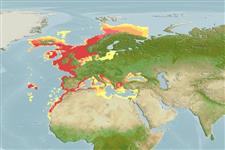Merluccius merluccius (Linnaeus, 1758)
European hake
Add your observation in Fish Watcher
| Native range | All suitable habitat | Point map | Year 2050 |

|
| This map was computer-generated and has not yet been reviewed. |
| Merluccius merluccius AquaMaps Data sources: GBIF OBIS |
Upload your photos and videos
Pictures | Stamps, coins, misc. | Google imageMerluccius merluccius
Picture by Svensen, R.
Pictures | Stamps, coins, misc. | Google imageMerluccius merluccius
Picture by Svensen, R.
Common names from other countries
Classification / Names Κοινά ονόματα | Συνώνυμα | Catalog of Fishes(Γένος, Είδη) | ITIS | CoL | WoRMS | Cloffa
> Gadiformes (Cods) > Merlucciidae (Merluccid hakes)
Etymology: Merluccius: Latin, mar, maris = the sea + Latin, lucius = pike (Ref. 45335).
More on author: Linnaeus.
Etymology: Merluccius: Latin, mar, maris = the sea + Latin, lucius = pike (Ref. 45335).
More on author: Linnaeus.
Environment: milieu / climate zone / depth range / distribution range Οικολογία
Θαλασσινό(ά) βενθικό(ς); εύρος βάθους 18 - 1075 m (Ref. 58452), usually 70 - 400 m (Ref. 35388). Temperate; 76°N - 18°N, 30°W - 42°E (Ref. 58452)
Κατανομή Χώρες | Περιοχές FAO | Οικοσυστήματα | Παρουσίες | Point map | Εισαγωγές | Faunafri
Eastern Atlantic: Norway and Iceland, southward to Mauritania. Also in the Mediterranean Sea and along the southern coast of the Black Sea.
Length at first maturity / Μέγεθος / Βάρος / Age
Maturity: Lm 42.1, range 20 - 70 cm
Max length : 140 cm TL αρσενικό/απροσδιόριστο; (Ref. 1371); common length : 45.0 cm TL αρσενικό/απροσδιόριστο; (Ref. 1371); μεγ. δημοσιευμένο βάρος: 15.0 kg (Ref. 1371); μεγ. αναφερόμενη ηλικία: 20 έτη (Ref. 35388)
Max length : 140 cm TL αρσενικό/απροσδιόριστο; (Ref. 1371); common length : 45.0 cm TL αρσενικό/απροσδιόριστο; (Ref. 1371); μεγ. δημοσιευμένο βάρος: 15.0 kg (Ref. 1371); μεγ. αναφερόμενη ηλικία: 20 έτη (Ref. 35388)
Short description Κλείδες προσδιορισμού | Μορφολογία | Μορφομετρία
Ραχιαίες άκανθες (συνολικά) : 0; Μαλακές ραχιαίες ακτίνες (συνολικά) : 43 - 51; Μαλακές εδρικές ακτίνες: 36 - 40. Inside of mouth and branchial cavity black. Second dorsal and anal fins notched. First vertebra and neural spine attached to skull. Vertebrae 50-52.
Minimum depth from Ref. 128002. Found usually between 70 and 370 m depth. Adults live close to the bottom during day-time, but move off-bottom at night. Adults feed mainly on fish (small hakes, anchovies, pilchard, herrings, cod fishes, sardines and gadoid species) and squids. The young feed on crustaceans (especially euphausiids and amphipods). Are batch spawners (Ref. 51846). Almost entirely marketed fresh, whole or filleted, to specialized restaurants or retail markets (Ref. 58452). Utilized fresh, dried or salted and frozen; can be steamed, fried, microwaved and baked (Ref. 9988). Stocks seem to be over-fished (Ref. 35388).
Life cycle and mating behavior Γεννητική Ωρίμανση | Αναπαραγωγή | Γεννοβολία | Αβγά | Γονιμότητα | Προνύμφες
Continuous recruitment of oocytes connotes indeterminate fecundity for this species (Ref. 79799).
Main reference
Upload your references | Αναφορές | Συντονιστής | Συνεργάτες
Cohen, D.M., T. Inada, T. Iwamoto and N. Scialabba, 1990. FAO species catalogue. Vol. 10. Gadiform fishes of the world (Order Gadiformes). An annotated and illustrated catalogue of cods, hakes, grenadiers and other gadiform fishes known to date. FAO Fish. Synop. 125(10). Rome: FAO. 442 p. (Ref. 1371)
IUCN Red List Status (Ref. 130435: Version 2024-2)
Least Concern (LC) ; Date assessed: 01 October 2015
Threat to humans
Harmless
Human uses
αλιεία: πολύ εμπορικό; αλιεία αναψυχής: ναί
FAO(αλιεία: Παραγωγή, species profile; publication : search) | FIRMS (Stock assessments) | FishSource | Η θάλασσα γύρω μας
Περισσότερες πληροφορίες
Population dynamics
Παράμετροι Αύξησης
Max. ages / sizes
Length-weight rel.
Length-length rel.
Length-frequencies
Mass conversion
Στρατολόγηση
Αφθονία
Παράμετροι Αύξησης
Max. ages / sizes
Length-weight rel.
Length-length rel.
Length-frequencies
Mass conversion
Στρατολόγηση
Αφθονία
Life cycle
Αναπαραγωγή
Γεννητική Ωρίμανση
Γονιμότητα
Γεννοβολία
Spawning aggregations
Αβγά
Egg development
Προνύμφες
Δυναμική προνυμφών
Αναπαραγωγή
Γεννητική Ωρίμανση
Γονιμότητα
Γεννοβολία
Spawning aggregations
Αβγά
Egg development
Προνύμφες
Δυναμική προνυμφών
Physiology
Body composition
Nutrients
Κατανάλωση οξυγόνου
Κολυμβητικός τύπος
Ταχύτητα κολύμβησης
Visual pigments
Fish sound
Diseases & Parasites
Toxicity (LC50s)
Body composition
Nutrients
Κατανάλωση οξυγόνου
Κολυμβητικός τύπος
Ταχύτητα κολύμβησης
Visual pigments
Fish sound
Diseases & Parasites
Toxicity (LC50s)
Genetics
Γενετική
Heterozygosity
Κληρονομικότητα
Γενετική
Heterozygosity
Κληρονομικότητα
Human related
Aquaculture systems
Προφίλ υδατοκαλλιεργειών
Στελέχοι
Ciguatera cases
Stamps, coins, misc.
Aquaculture systems
Προφίλ υδατοκαλλιεργειών
Στελέχοι
Ciguatera cases
Stamps, coins, misc.
Εργαλεία
Bio-Quiz | E-book | Οδηγός πεδίου | Κλείδες προσδιορισμού | Ανάλυση κατά μήκος συνθέσεων | Εργαλείο ιστορίας ζωής | Σημειακός χάρτης | Classification Tree
| Catch-MSY |
Special reports
Download XML
Διαδικτυακές πηγές
Aquatic Commons | BHL | Cloffa | BOLDSystems | Websites from users | Check FishWatcher | CISTI | Catalog of Fishes(Γένος, Είδη) | DiscoverLife | DORIS | ECOTOX | Faunafri | Fishtrace | GenBank(genome, nucleotide) | GloBI | GOBASE | | Google Books | Google Scholar | Google | IGFA World Record | MitoFish | Εθνικές βάσεις δεδομένων | Otolith Atlas of Taiwan Fishes | PubMed | Reef Life Survey | Scirus | SeaLifeBase | Δέντρο Ζωής | Wikipedia(Go, αναζήτηση) | World Records Freshwater Fishing | Zoological Record
Estimates based on models
Preferred temperature (Ref. 115969): 6.9 - 15.4, mean 10.2 (based on 672 cells).
Phylogenetic diversity index (Ref. 82804): PD50 = 0.5000 [Uniqueness, from 0.5 = low to 2.0 = high].
Bayesian length-weight: a=0.00468 (0.00421 - 0.00519), b=3.12 (3.09 - 3.15), in cm Total Length, based on LWR estimates for this species (Ref. 93245).
Τροφικό Επίπεδο (Ref. 69278): 4.4 ±0.0 se; based on diet studies.
Ελαστικότητα (Ref. 120179): Μεσαίο(α), ελάχιστος χρόνος για διπλασιασμό πληθυσμού 1,4 - 4,4 έτη (K=0.1; tm=3, tmax=20; Fecundity=7 million).
Prior r = 0.48, 95% CL = 0.32 - 0.72, Based on 34 full stock assessments.
Fishing Vulnerability (Ref. 59153): High vulnerability (65 of 100).
Climate Vulnerability (Ref. 125649): Moderate vulnerability (39 of 100).




